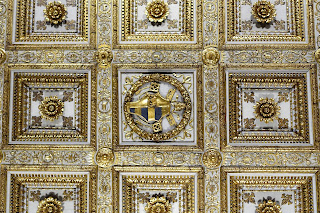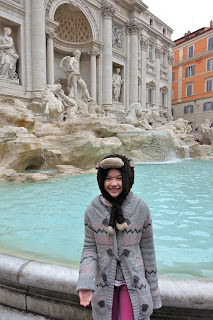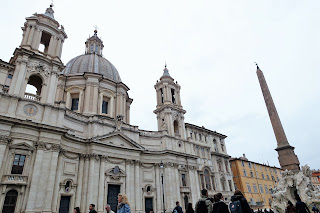Largo di Torre Argentina cat sanctuary
A row of Vespas lined up near a 5th-century church. It doesn't get much more Roman than this
Just five minutes on foot from the Augusta Lucilla Palace is the Basilica di Santa Maria Maggiore, one of Rome's four patriarchal basilicas. The church stands on Esquiline Hill, where according to legend snow fell in the summer of the year 358. Although the basilica dates back to the 5th century, it has undergone a number of alterations over the centuries - according to my guidebook, the belfry is 14th-century Romanesque, while the facade is 18th-century baroque, as is largely the interior. In any event, it served as a glorious introduction to the architectural wonders of Rome:
My daughter was suitably impressed by the interior, but for her, Italy means gelato, and she was looking forward to sampling as many different flavors as she could on this trip. Her first two were milk chocolate and dark chocolate, purchased near the basilica, but she would eventually branch out into tiramisu, hazelnut, lemon, nutella, pistachio, pineapple, strawberry and salted caramel among others while in Italy. Note the mask - Amber unfortunately came down with a bad case of nasal congestion just as our vacation started, but trooper that she is, wouldn't let it stop her from enjoying herself (or the gelato):
The other thing my daughter indulged in on this trip was pizza, as did I as the two of us dined at a pizzeria around the corner from the hotel:
The next day the sightseeing began in earnest. One of Shu-E's favorite movies is Roman Holiday, so our first stop on Monday morning was the Piazza di Spagna and the Spanish Steps, twenty-one minutes on foot from the Augusta Lucilla Palace:
The 135-step staircase was designed in 1725:
The girls stand by the Barcaccia, the "sinking boat" fountain, dating from 1627:
The view from the top of the steps:
Behind us stands the 1585 Chiesa della Trinità dei Monti, commissioned by King Louis XII of France. The church is unfortunately closed on Mondays, so we couldn't go in to have a look at its famous frescoes:
From the Spanish Steps we walked to see Rome's largest and most famous fountain. Taking up one side of the 17th-century Palazzo Poli, Trevi Fountain is baroque at its most flamboyant, featuring Neptune and his seahorses, and flanked by Abundance on the left and Salubrity on the right:
The fountain was designed by Nicola Salvi in 1732 and is fed by the Aqua Virgo, a 2000-year-old aqueduct that connects Rome with spring water 19 kilometers from the capital. The tradition is to toss a coin into the water to ensure that one day you'll return to the city. At the time we showed up, the fountain had been turned off to allow workers to vacuum up the €3000 in coins that are thrown on average each day into the water:
Taking a gelato break while waiting for the fountain to be turned on:
With impeccable timing, the waters started flowing just as we finished up with our ice cream, and so we did as the tourists do:
With the square around Trevi Fountain beginning to fill up with visitors, we next headed over to the Pantheon, the best preserved of Rome's ancient monuments. It was built by Hadrian in CE 120 over Marcus Agrippa's earlier 27 BCE temple, and is still a working church. The exterior is huge, with the monumental entrance portico consisting of 16 13-meter-high columns and a pair of 20-ton bronze doors. The inscription translates as "Marcus Agrippa, son of Lucius, consul for the third time, built this":
The interior is a completely different experience, with the largest unreinforced concrete dome ever built making for an almost TARDIS-like disorientating experience:
The diameter of the dome is exactly equal to the building's interior height of 43.3 meters (142 feet). Light and rain enter through the 8.7 meter (28.5 feet)-diameter opening - the sloping marble floor has 22 holes to drain away the water:
The main altar:
The tombs of King Umberto I...:
...Raphael...:
...and King Vittorio Emanuele II:
It had been a busy morning, so we took a break for lunch at a ristorante close to the Pantheon, where I had the carbonara:
Sated, it was off to see the Largo di Torre Argentina. This square, with the remains of four temples, was the site of Julius Caesar's assassination in 44 BCE - the ruins include part of the portico of Pompey, where the dictator was stabbed to death:
What made the Largo di Torre Argentina for Amber, however, wasn't the history but its population of 140 or so feral cats, which are taken care of by a group of volunteers. We made a donation to their cause by purchasing a tote bag from their small on-site visitors center:
Our final stop on this Monday before heading back to the hotel was to Piazza Navona. It was laid out in the 15th-century over the site of the 1st-century Stadio di Domiziano (Domitian's Stadium) and was once home to Rome's main market. It now attracts hawkers, street artists and tourists:
The centerpiece of the piazza is Gian Lorenzo Bernini's Fontana dei Quattro Fiumi (Fountain of the Four Rivers, with the rivers in question being the Nile, Ganges, Danube and Plate), designed in 1651:
While my wife took a rest in the piazza, my daughter and I went underground to see what remained of the Stadio di Domiziano:
Orderly transitions of administrations were obviously not the case in Imperial Rome:
It was getting late in the afternoon, so the three of us left the piazza and headed back toward our hotel, passing by examples of men's fashion the likes of which I could never hope to look good wearing:
One of these wine bottles is not the the other, one of these wine bottles doesn't belong:
Arriving back at the Augusta Lucilla Palace, located conveniently close to Roma Termini:
Shu-E has been choosing to skip dinners in recent months, so Amber and I went out to a cafe on the corner, where I enjoyed the lasagna:
To be continued...
Anita Ekberg in La Dolce Vita





















































No comments:
Post a Comment